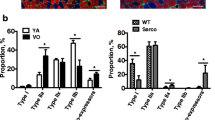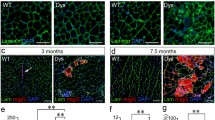Abstract
Sarcopenia is a major contributor to the loss of independence and deteriorating quality of life in elderly individuals, it manifests as a decline in skeletal muscle mass and strength beyond the age of 65. Muscle fibre atrophy is a major contributor to sarcopenia and the most severely atrophic fibres are commonly found in elderly muscles to have permanently lost their motor nerve input. By contrast with elderly fibres, when fibres in young animals lose their motor input they normally mount a response to induce restoration of nerve contact, and this is mediated in part by upregulated expression of the nerve cell adhesion molecule (NCAM). Therefore, skeletal muscles appear to progressively lose their ability to become reinnervated, and here we have investigated whether this decline occurs via loss of the muscle’s ability to upregulate NCAM in response to denervation. We performed partial denervation (by peripheral nerve crush) of the extensor digitorum longus muscle of the lower limb in both young and elderly mice. We used immunohistochemistry to compare relative NCAM levels at denervated and control innervated muscle fibres, focused on measurements at neuromuscular junctional, extra-junctional and cytoplasmic locations. Muscle fibres in young animals responded to denervation with significant (32.9 %) increases in unpolysialylated NCAM at extra-junctional locations, but with no change in polysialylated NCAM. The same partial denervation protocol applied to elderly animals resulted in no significant change in either polysialylated or unpolysialylated NCAM at junctional, extra-junctional or cytoplasmic locations, therefore muscle fibres in young mice upregulated NCAM in response to denervation but fibres in elderly mice failed to do so. Elevation of NCAM levels is likely to be an important component of the muscle fibre’s ability to attract or reattract a neural input, so we conclude that the presence of increasing numbers of long-term denervated fibres in elderly muscles is due, at least in part, to the fibre’s declining ability to mount a normal response to loss of motor input.





Similar content being viewed by others
References
Abellan van Kan G (2009) Epidemiology and consequences of sarcopenia. J Nutr Health Aging 13:708–712
Andersson A-M, Olsen M, Zhernosekov D, Gaardsvoll H, Krog L, Linnemann D, Bock E (1993) Age-related changes in expression of the neural cell adhesion molecule in skeletal muscle: a comparative study of newborn, adult and aged rats. Biochem J 290:641–648
Angata K, Fukuda M (2003) Polysialyltransferases: major players in polysialic acid synthesis on the neural cell adhesion molecule. Biochimie 85:195–206
Ballak SB, Degens H, de Haan A, Jaspers RT (2014) Aging related changes in determinants of muscle force generating capacity: a comparison of muscle aging in men and male rodents. Ageing Res Rev 14:43–55
Brady J, Sheard PW (2015) Implementation of internal intensity controls for semi-quantitative immunohistochemistry. In: Proc NZ Microsc Soc, Dunedin
Breen L, Phillips SM (2011) Skeletal muscle protein metabolism in the elderly: interventions to counteract the ‘anabolic resistance’of ageing. Nutr Metab (Lond) 8:68
Brown M, Holland R, Hopkins W (1981) Motor nerve sprouting. Ann Rev Neur 4:17–42
Carlson BM, Faulkner JA (1989) Muscle transplantation between young and old rats: age of host determines recovery. Am J Physiol 256(C25):C1262–C1266
Chai RJ, Vukovic J, Dunlop S, Grounds MD, Shavlakadze T (2011) Striking denervation of neuromuscular junctions without lumbar motoneuron loss in geriatric mouse muscle. PLoS One 6:e28090
Covault J, Sanes JR (1985) Neural cell adhesion molecule (N-CAM) accumulates in denervated and paralyzed skeletal muscles. Proc Natl Acad Sci 82:4544–4548
Covault J, Sanes JR (1986) Distribution of N-CAM in synaptic and extrasynaptic portions of developing and adult skeletal muscle. J Cell Biol 102:716–730
Covault J, Merlie JP, Goridis C, Sanes JR (1986) Molecular forms of N-CAM and its RNA in developing and denervated skeletal muscle. J Cell Biol 102:731–739
DeChiara TM, Bowen DC, Valenzuela DM, Simmons MV, Poueymirou WT, Thomas S, Kinetz E, Compton DL, Rojas E, Park JS, Smith C, DiStefano PS, Glass DJ, Burden SJ, Yancopoulos GD (1996) The receptor tyrosine kinase MuSK is required for neuromuscular junction formation in vivo. Cell 85:501–512
Deschenes M (2011) Motor unit and neuromuscular junction remodeling with aging. Curr Aging Sci 4:209–220
Deschenes MR, Wilson MH (2003) Age-related differences in synaptic plasticity following muscle unloading. J Neurobiol 57:246–256
Edelman G (1983) Cell adhesion molecules. Science 219:450–457
Evans WJ, Lexell J (1995) Human aging, muscle mass, and fiber type composition. J Gerontol A 50:11–16
Ferraro E, Molinari F, Berghella L (2012) Molecular control of neuromuscular junction development. J Cachexia Sarc Musc 3:13–23
Gallo G, Letourneau PC (2004) Regulation of growth cone actin filaments by guidance cues. J Neurobiol 58:92–102
Gautam M, Noakes PG, Moscoso L, Rupp F, Scheller RH, Merlie JP, Sanes JR (1996) Defective neuromuscular synaptogenesis in agrin-deficient mutant mice. Cell 85:525–535
Grumet M, Rutishauser U, Edelman GM (1982) Neural cell adhesion molecule is on embryonic muscle cells and mediates adhesion to nerve cells in vitro. J Cell Biol 97:145–152
Herbst R, Burden SJ (2000) The juxtamembrane region of MuSK has a critical role in agrin-mediated signaling. EMBO J 19:67–77
Hopkins W, Slack J (1981) The sequential development of nodal sprouts in mouse muscles in response to nerve degeneration. J Neurocytol 10:537–556
Ide C (1996) Peripheral nerve regeneration. Neurosci Res 25:101–121
Jamali AA, Afshar P, Abrams RA, Lieber RL (2002) Differential expression of neural cell adhesion molecule (NCAM) after tenotomy in rabbit skeletal muscle. J Orthopaed Res 20:364–369
Janssen I, Shepard DS, Katzmarzyk PT, Roubenoff R (2004) The healthcare costs of sarcopenia in the United States. J Am Geriatr Soc 52:80–85
Kulakowski SA, Parker SD, Personius KE (2011) Reduced TrkB expression results in precocious age-like changes in neuromuscular structure, neurotransmission, and muscle function. J Appl Physiol 111:844–852
Lexell J, Downham D (1991) The occurrence of fibre-type grouping in healthy human muscle: a quantitative study of cross-sections of whole vastus lateralis from men between 15 and 83 years. Acta Neuropath 81:377–381
Lexell J, Downham D, Sjöström M (1986) Distribution of different fibre types in human skeletal muscles: fibre type arrangement in m. vastus lateralis from three groups of healthy men between 15 and 83 years. J Neurol Sci 72:211–222
Lexell J, Taylor CC, Sjöström M (1988) What is the cause of the ageing atrophy?: total number, size and proportion of different fiber types studied in whole vastus lateralis muscle from 15-to 83-year-old men. J Neurol Sci 84:275–294
Lichtman JW, Sanes JR (2003) Watching the neuromuscular junction. J Neurocytol 32:767–775
Martini R (1994) Expression and functional roles of neural cell surface molecules and extracellular matrix components during development and regeneration of peripheral nerves. J Neurocytol 23:1–28
Matkowskyj KA, Cox R, Jensen RT, Benya RV (2003) Quantitative immunohistochemistry by measuring cumulative signal strength accurately measures receptor number. J Histochem Cytochem 51:205–214
Matsumiya LC, Sorge RE, Sotocinal SG, Tabaka JM, Wieskopf JS, Zaloum A, King OD, Mogil JS (2012) Using the Mouse Grimace Scale to reevaluate the efficacy of postoperative analgesics in laboratory mice. J Am Assoc Lab Anim Sci 51:42–49
McMahon CD, Shavlakadze T, Grounds MD (2011) Role of IGF-1 in age-related loss of skeletal muscle mass and function. In: Lynch GS (ed) Sarcopenia–age-related muscle wasting and weakness. Springer, Dordrecht, pp 393–418
Merlie J, Isenberg K, Russell S, Sanes J (1984) Denervation supersensitivity in skeletal muscle: analysis with a cloned cDNA probe. J Cell Biol 99:332–335
Mitchell WK, Williams J, Atherton P, Larvin M, Lund J, Narici M (2012) Sarcopenia, dynapenia, and the impact of advancing age on human skeletal muscle size and strength; a quantitative review. Front Physiol 3:260. doi:10.3389/fphys.2012.00260
Olsen M, Krog L, Edvardsen K, Skovgaard LT, Bock E (1993) Intact transmembrane isoforms of the neural cell adhesion molecule are released from the plasma membrane. Biochem J 295:833–840
Panicker AK, Buhusi M, Thelen K, Maness PF (2003) Cellular signalling mechanisms of neural cell adhesion molecules. Front Biosci 8:d900–d911
Pestronk A, Drachman DB, Griffin JW (1980) Effects of aging on nerve sprouting and regeneration. Exp Neurol 70:65–82
Piétri-Rouxel F et al (2009) DHPR α1S subunit controls skeletal muscle mass and morphogenesis. EMBO J 29:643–654
Rønn LCB, Berezin V, Bock E (2000) The neural cell adhesion molecule in synaptic plasticity and ageing. Int J Dev Neurosci 18:193–199
Rowan SL, Rygiel K, Purves-Smith FM, Solbak NM, Turnbull DM, Hepple RT (2012) Denervation causes fiber atrophy and myosin heavy chain co-expression in senescent skeletal muscle. PLoS One 7:e29082
Rutishauser U (1985) Influences of the neural cell adhesion molecule on axon growth and guidance. J Neurosci Res 13:123–131
Sanes JR, Yamagata M (2009) Many paths to synaptic specificity. Ann Rev Cell Dev Biol 25:161–195
Secher T (2010) Soluble NCAM In: Berezin V (ed) Structure and function of the neural cell adhesion molecule NCAM. Springer, New York, pp 227–242
Sheard PW, Anderson RD (2012) Age-related loss of muscle fibres is highly variable amongst mouse skeletal muscles. Biogerontology 13:157–167
Tam S, Gordon T (2003) Mechanisms controlling axonal sprouting at the neuromuscular junction. J Neurocytol 32:961–974
Valdez G, Tapia JC, Kang H, Clemenson GD, Gage F, Lichtman JW, Sanes JR (2010) Attenuation of age-related changes in mouse neuromuscular synapses by caloric restriction and exercise. Proc Nat Acad Sci USA 107:14863–14868
Vaughan DW (1992) Effects of advancing age on peripheral nerve regeneration. J Comp Neurol 323:219–237
Verdú E, Ceballos D, Vilches JJ, Navarro X (2000) Influence of aging on peripheral nerve function and regeneration. J Periph Nerv Sys 5:191–208
Viguie CA, Lu D-X, Huang S-K, Rengen H, Carlson BM (1997) Quantitative study of the effects of long-term denervation on the extensor digitorum longus muscle of the rat. Anat Rec 248:346–354
Walsh FS, Doherty P (1991) Structure and function of the gene for neural cell adhesion molecule. Seminars in neuroscience 4:271–284
Walsh FS, Hobbs C, Wells DJ, Slater CR, Fazeli S (2000) Ectopic expression of NCAM in skeletal muscle of transgenic mice results in terminal sprouting at the neuromuscular junction and altered structure but not function. Mol Cell Neurosci 15:244–261
Yumoto N, Kim N, Burden SJ (2012) Lrp4 is a retrograde signal for presynaptic differentiation at neuromuscular synapses. Nature 489:438–442
Acknowledgments
This work was supported by the Department of Physiology at the University of Otago. AG was the recipient of a Department of Physiology Master’s Scholarship and Postgraduate Publishing Bursary. We thank Dr Jon Cornwall, Navneet Lal, Kathrine Nielsen and Johnranin Brady for their thoughtful contributions.
Author information
Authors and Affiliations
Corresponding author
Rights and permissions
About this article
Cite this article
Gillon, A., Sheard, P. Elderly mouse skeletal muscle fibres have a diminished capacity to upregulate NCAM production in response to denervation. Biogerontology 16, 811–823 (2015). https://doi.org/10.1007/s10522-015-9608-6
Received:
Accepted:
Published:
Issue Date:
DOI: https://doi.org/10.1007/s10522-015-9608-6




